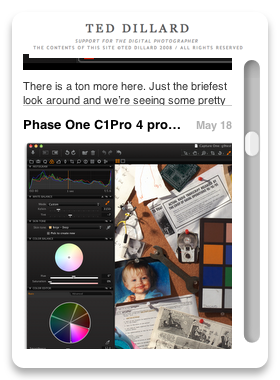File delivery standards- proposal
What follows is a list I've complied for developing a strategy. These are based on the closest thing to an industry standard I can get to, and constant discussion with everyone from photographers right to the guy on press.
After you get your own house in order, the first step? Talk to the client. Of course, right? We are in the communication business, after all...
The second biggest issue, in my opinion, is to determine if you want to "Early Bind" or "Late Bind". That is, do you want to dedicate the file to a specific purpose when you deliver it, or do you want to deliver the most data and allow the file to be "purposed" by the production guys. Again, communication.
Here, for what it's worth, is my guideline. (ducks, runs away...)
Step 1: Workstation setup and standards
Good color-accurate calibrated display
General purpose calibration settings: 6500K, 2.2 Gamma, Luminance ~120
Standardized Color Settings in Photoshop- NA Prepress Defaults
Step 2: Communication with client
Determine client use and preferences for file delivery
Negotiate fees for preparation to those requests
Establish reasonable client expectations for color accuracy and proofing processes
Step 3: Determine processing "mode", ie, "Early Binding" or "Late Binding".
Early Binding- Files are processed for specific use as specified by client.
Examples: Offset printing, web/multimedia, fine reproduction
Late Binding- Files are processed to accommodate reasonable forseeable usage, allowing editing in post for specific applications.
Suggested procedures: (all presuming "unless otherwise requested by client")
Early Binding:
(RGB can be "backwards converted", that is, converted to RGB from the CMYK to assure displayed colors can be printed.)
Late Binding:
I think these guidelines are general enough to give a good strategy, a roadmap, for any photographer, but specific enough to be of value... Responsible handling of files, in any case, demands an understanding of the issues, and a thoughtful approach to how to best protect yourself as well as your client, in fulfilling the assignment.
Ultimately the goal is a good job, a happy client, and more work, right?
Labels: File delivery, File delivery standards, industry standard








